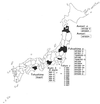New Ehrlichia species closely related to Ehrlichia chaffeensis isolated from Ixodes ovatus ticks in Japan
- PMID: 10747103
- PMCID: PMC86441
- DOI: 10.1128/JCM.38.4.1331-1338.2000
New Ehrlichia species closely related to Ehrlichia chaffeensis isolated from Ixodes ovatus ticks in Japan
Abstract
Seven Ehrlichia strains (six HF strains and one Anan strain) that were obtained from laboratory mice by intraperitoneally inoculating homogenates of adult Ixodes ovatus collected in Japan were characterized. 16S rRNA sequences of all six HF strains were identical, and the sequences were 99.7, 98.2, and 97.7% identical to those of Anan strain, Ehrlichia chaffeensis (human monocytic ehrlichiosis agent), and E. muris, respectively. Partial GroEL amino acid sequencing also revealed that the six HF strains had identical sequences, which were 99.0, 98.5, and 97.3% identical to those of E. chaffeensis, the Anan strain, and E. canis, respectively. All HF strains were lethal to mice at higher dosages and intraperitoneal inoculation, whereas the Anan or E. muris strain induced only mild clinical signs. Light and electron microscopy of moribund mice inoculated with one of the HF strains revealed severe liver necrosis and the presence of numerous ehrlichial inclusions (morulae) in various organs. The study revealed that members of E. canis genogroup are naturally present in Ixodes ticks. HF strains that can cause severe illness in immunocompetent laboratory mice would be valuable in studying the pathogenesis and the roles of both cellular and humoral immune responses in ehrlichiosis caused by E. canis genogroup.
Figures






References
-
- Anderson B E, Greene C E, Jones D C, Dawson J E. Ehrlichia ewingii sp. nov., the etiologic agent of canine granulocytic ehrlichiosis. Int J Syst Bacteriol. 1992;42:299–302. - PubMed
-
- Anderson B E, Sims K G, Olson J G, Childs J M, Piesman J F, Happ C M, Maupin G O, Johnson B J B. Amblyomma americanum: a potential vector of human ehrlichiosis. Am J Trop Med Hyg. 1993;49:239–244. - PubMed
-
- Buller R S, Arens M, Hmiel S P, Paddock C, Sumner J W, Rikihisa Y, Unver A, Graudreauls-Keener M, Marinian F A, Liddell A M, Schmulewitz N, Storch G. Ehrlichia ewingii, a newly recognized agent of human ehrlichiosis. New Engl J Med. 1999;341:148–155. - PubMed
Publication types
MeSH terms
Substances
Associated data
- Actions
- Actions
- Actions
- Actions
Grants and funding
LinkOut - more resources
Full Text Sources
Molecular Biology Databases
Research Materials
Miscellaneous

